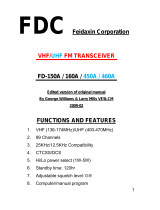
1–1
1 CONTENTS
1 CONTENTS ........................................................... 1
2 BEFORE STARTING ...............................................2-1
3 PREPARATION .....................................................3-1
SUPPLIED ACCESSORIES ...............................................................3-1
INSTALLING THE ANTENNA ............................................................3-1
INSTALLING THE BATTERY PACK ...................................................3-1
INSTALLING ALKALINE BATTERIES ................................................3-1
INSTALLING THE BELT CLIP ...........................................................3-2
INSTALLING THE HAND STRAP ......................................................3-2
CHARGING THE BATTERY PACK .....................................................3-2
BATTERY LIFE .................................................................................3-3
CONNECTING TO A CIGARETTE LIGHTER SOCKET .........................3-3
CONNECTING TO A REGULATED POWER SUPPLY .........................3-3
4 GETTING ACQUAINTED ...........................................4-1
KEY AND CONTROL KNOB OPERATIONS ........................................ 4-1
DISPLAY .......................................................................................... 4-3
5 BASIC OPERATIONS ..............................................5-1
SWITCHING THE POWER ON/ OFF .................................................. 5-1
ADJUSTING THE INTERNAL CLOCK ................................................ 5-1
ADJUSTING THE VOLUME ..............................................................5-1
VOLUME BALANCE (BAND A/B) ......................................................5-1
SELECTING DUAL BAND MODE/ SINGLE BAND MODE ..................5-1
SELECTING AN OPERATION BAND .................................................5-1
SELECTING A FREQUENCY BAND ...................................................5-2
SELECTING THE DEMODULATION MODE .......................................5-2
SELECTING A FREQUENCY .............................................................5-2
ADJUSTING THE SQUELCH ............................................................. 5-3
TRANSMITTING ..............................................................................5-3
MONITOR ........................................................................................5-3
FUNCTION SELECT MODE ............................................................... 5-3
6 MENU MODE .......................................................6-1
MENU ACCESS ................................................................................6-1
CHARACTER ENTRY ........................................................................6-1
MENU CONFIGURATION .................................................................. 6-2
7 OPERATING THROUGH FM REPEATERS .......................7-1
REPEATER ACCESS ......................................................................... 7-1
TRANSMITTING A 1750 Hz TONE ...................................................7-3
REVERSE FUNCTION ....................................................................... 7-3
8 MEMORY CHANNEL ..............................................8-1
SIMPLEX & REPEATER OR ODD-SPLIT MEMORY CHANNEL? .......8-1
MEMORY CHANNEL LIST ...............................................................8-1
RECALLING A MEMORY CHANNEL .................................................8-2
EDITING MEMORY CHANNEL .........................................................8-3
CALL CHANNEL MEMORY (SIMPLEX) ............................................8-4
CALL CHANNEL MEMORY (ODD-SPLIT) .........................................8-4
CALL CHANNEL LIST ......................................................................8-4
MEMORY GROUP ............................................................................8-4
MEMORY SHIFT .............................................................................8-5
9 SCAN ................................................................9-1
SELECTING A SCAN RESUME METHOD ..........................................9-1
BAND SCAN ..................................................................................... 9-1
PROGRAM SCAN ............................................................................. 9-2
MHz SCAN ....................................................................................... 9-2
MEMORY SCAN ...............................................................................9-2
GROUP LINK SCAN .........................................................................9-3
PRIORITY SCAN ..............................................................................9-4
CALL SCAN .....................................................................................9-4
SCAN AUTO BACKLIGHT .................................................................9-4
10 CTCSS/DCS/CROSS TONE .................................... 10-1
CTCSS ...........................................................................................10-1
DCS ...............................................................................................10-2
CROSS TONE ................................................................................. 10-3
11 DUAL TONE MULTI-FREQUENCY(DTMF) ................... 11-1
MANUAL DIALING ......................................................................... 11-1
AUTOMATIC DIALER .....................................................................11-1
EchoLink MEMORY .......................................................................11-2
12 OTHER OPERATIONS .......................................... 12-1
FREQUENCY STEP SIZE ................................................................12-1
FINE TUNING ................................................................................. 12-1
ATTENUATOR (ATT) .......................................................................12-1
PROGRAMMABLE VFO .................................................................. 12-2
BEAT SHIFT ...................................................................................12-2
IF/ DETECT OUTPUT MODE ........................................................... 12-2
FM NARROW ................................................................................. 12-3
BAR ANTENNA ..............................................................................12-3
TX INHIBIT ....................................................................................12-3
TIME-OUT TIMER ..........................................................................12-4
MICROPHONE SENSITIVITY .........................................................12-4
SETTING RECEIVING FILTERS .......................................................12-4
VOX (VOICE-OPERATED TRANSMISSION) ....................................12-5
PITCH FREQUENCY .......................................................................12-6
CW REVERSE ..............................................................................12-6
LED CONTROL ............................................................................... 12-6
DISPLAY ILLUMINATION ...............................................................12-7
POWER ON MESSAGE ..................................................................12-7
SINGLE BAND DISPLAY ................................................................12-8
METER TYPE .................................................................................12-8
DISPLAY BACKGROUND COLOR ................................................... 12-8
AUDIO EQUALIZER (TX/RX) ..........................................................12-9
KEY BEEP ......................................................................................12-9
BEEP VOLUME ...........................................................................12-10
BATTERY SAVER .........................................................................12-10
AUTO POWER OFF (APO) ............................................................12-10
BATTERY LEVEL ..........................................................................12-10
PROGRAMMABLE FUNCTION KEYS ............................................12-11
KEY LOCK .................................................................................... 12-12
VOLUME LOCK ............................................................................12-12
DISPLAY UNIT ............................................................................. 12-12
OUTPUT DESTINATION INTERFACE (USB/Bluetooth) .................12-13
SELECTING A LANGUAGE ...........................................................12-14
VERIFYING THE FIRMWARE VERSION ........................................12-14
TRANSCEIVER RESET .................................................................12-14
13 GPS .............................................................. 13-1
BUILT-IN GPS FUNCTION ON/ OFF ................................................13-1
SETTING MY POSITION DATA .......................................................13-1
MARK FUNCTION ..........................................................................13-4
POSITION MEMORY LIST .............................................................13-4
TARGET POINT ..............................................................................13-6
TRACK LOG ...................................................................................13-6
14 APRS
®
........................................................... 14-1
BASIC SETTINGS ...........................................................................14-1
POSITION COMMENT .................................................................... 14-3
STATUS TEXT ................................................................................14-3
STATION LIST ................................................................................ 14-5
APRS MESSAGE FUNCTIONS ........................................................14-9
PROGRAMMING A PACKET PATH ...............................................14-11
SETTING INTERNAL TNC ............................................................14-12
APRS LOCK .................................................................................14-13
SETTING TX BEACON ..................................................................14-13
SETTING BEACON INFORMATION ...............................................14-14
OBJECT FUNCTIONS ...................................................................14-15
QSY FUNCTION ...........................................................................14-16
SETTING SmartBeaconing
TM
........................................................14-17
SETTING WAY POINT ..................................................................14-18
SETTING PACKET FILTER ............................................................14-19
STORING USER PHRASES ..........................................................14-19
STORING AUTO MESSAGE REPLY ..............................................14-19
SETTING NOTIFICATION SOUND ................................................. 14-20
SETTING DISPLAY .......................................................................14-21
PC OUTPUT .................................................................................14-21
NETWORK ...................................................................................14-21
VOICE ALERT ..............................................................................14-22
PROGRAMMING MESSAGE GROUP CODE .................................14-22
PROGRAMMING BULLETIN GROUP CODE .................................14-22
15 BUILT-IN KISS TNC ............................................ 15-1
























